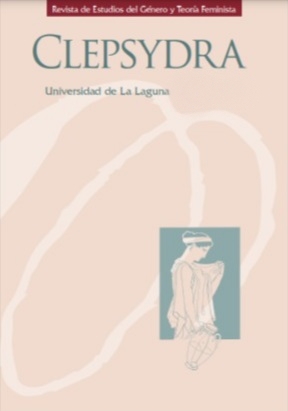La (in)visibilidad de las mujeres en los textos didácticos del judaísmo clásico
Resumen
Partiendo de la hipótesis de que los textos académicos de los Sabios del judaísmo clásico (siglos i-viii ec) forman parte de un ámbito restringido, frente a otros textos de compilación tardía, como son los denominados Tratados Menores del Talmud –orientados más bien a un ámbito público con intención didáctica–, leeremos uno de dichos tratados revisando la visibilidad (o la invisibilidad) de las mujeres a lo largo de sus contenidos y de sus argumentaciones. Se ha seleccionado para ello uno de esos textos éticos, Kallah Rabbati, por ser un tratado que ordena asuntos cotidianos que afectan a hombres y mujeres, como son las relaciones sexuales del matrimonio, además de contemplar otras consideraciones éticas sobre el comportamiento humano. A través del texto analizaremos el papel que las mujeres pudieron tener en el ámbito académico, para posteriormente analizar cómo se presentan en el discurso y considerar su posible papel como emisoras o como receptoras de estos textos didácticos del judaísmo clásico.
Citas
Amendola, Natasha. «Weaving Virtue: Laura Cereta as a New Penelope», en Green, Karen y Mews, Constant (eds.), Virtue Ethics for Women 1250-1500. The New Synthese Historical Library, 69. Dordrecht: Springer Science & Business Media, 2011, pp. 133-143.
Baskin, Judith. Midrashic Women. Formations of the Femenine in Rabbinic Literature. Hanover: Brandeis University Press, 2002.
Baumgarten, Elisheva. «A Separate people? Some directions for comparative research on medieval women». Journal of Medieval History, 34 (2008), pp. 212-228.
Boyarin, Daniel. Espacios fronterizos: judaísmo y cristianismo en la Antigüedad tardía. Madrid: Tro-tta, 2013.
Brodsky, David. A Bride without a Blessing. A Study in the Redaction and Context of Massekhet Kallah and Its Gemara. Tübingen, Mohr Siebeck, 2006.
Bronner, Leila L. «Hannah’s Prayer: Rabbinic Ambivalence». Shofar, 17/2 (1999), pp. 36-48.
Caballero Navas, Carmen. «Mujeres, cuerpos y literatura médica medieval en hebreo». Asclepio. Revista de Historia de la Medicina y de la Ciencia, LX/1 (2008), pp. 37-62.
Caballero Navas, Carmen. «Virtuous and Wise: Apprehending Female Medical Practice from Hebrew Texts on Women’s Health Care». Social History of Medicine, 32:4 (2019), pp. 691-711.
Cabré i Pairet, Montserrat. «Medieval women’s writing in Catalan: textual inscriptions if feminine authority». La Corónica. A Journal of Medieval Spanish Language, 32:1 (2003), pp. 23-41.
Epstein, Yachin. Studies in Massekhet Kallah Rabbati: text, redaction and period. (Hebreo). Tesis doctoral inédita. Hebrew University of Jerusalem, 2009 (https://sites.google.com/site/yachinepstein/Home/kallarabati).
Fonrobert, Charlotte Elisheva. «Yalta’s Ruse. Resistance against Rabbinic Menstrual Authority in Talmudic Literature», en Wasserfall, Rahel R. (ed.), Women and Water: Menstruation in Jewish Life and Law. Hanover: Brandeis University Press, 1999, pp. 60-81.
Ginzberg, Louis. Legends of the Jews. 2 vols. Philadelphia: The Jewish Publication Society, 2003.
Gribetz, Sarit Kattan. «Zekhut Imahot: Mothers, Fathers, and Ancestral Merit in Rabbinic Sources». Journal for the Study of Judaism, 49/2 (2018), pp. 263-296.
Hezser, Catherine. «Private and Public Education», en Hezser, C. (ed.), The Oxford Handbook of Jewish Daily Life in Roman Palestine. Oxford: Oxford University Press, 2010, pp. 465-481.
Ilan, Tal. Mine & Yours are Hers. Retrieving Women’s History from Rabbinic Literature. Leiden-New York-Köln: Brill, 1997.
Ilan, Tal. Integrating Women into Second Temple History. Tübingen: Mohr Siebeck, 1999.
Ilan, Tal. «Learned Jewish Women in Antiquity», en Ego, Beate y Merkel, Helmut (eds.), Religiöses Lernen in der biblischen, frühjüdischen und frühchristlichen Überlieferung. Tübingen: Mohr Siebeck, 2005, pp. 175-190.
Ilan, Tal. «The women as ‘other’ in the Rabbinic Literature», en Frey, Jörg et al. (eds.), Jewish Identity in the Greco-Roman World. Boston: Brill, 2007, pp.77-92.
Ilan, Tal. «Schriftzitierende Frauen in der rabbinischen Literatur», en Ilan, Tal; Miralles-Macía, Lorena y Nikolsky, Ronit (eds.), Die Bibel un die Frauen. Rabbinischee Literatur. Stuttgart: Kholhammer, 2020, pp. 49-71.
Herranz Pascual, Carmen. Los Sabios del Talmud. Barcelona: Riopiedras, 1997.
Labovitz, Gail. «Rabbis and “Guerrila Girls”. A Bavli Motif of the Female (Counter) Voice in the Rabbinic Legal System». Women in Judaism: A Multidisciplinary Journal, 20-2 (2013), pp. 1-35.
Labovitz, Gail. «A Man Spinning on His Thigh: Gender, Positive Time-Bound Commandments and Ritual Fringes Mishnah Mo‘ed Katan 3:4». Nashim, 28 (2015), pp. 75-87.
Miralles Maciá, Lorena. «Judaizing a Gentile Biblical Character through Fictive Biographical Reports: The Case of Bityah, Pharaoh’s Daughter, Moses’ Mother, According to Rabbinic Interpretations», en Cordoni, Constanza y Lange, Gerhard (eds.), Poetik, Exegese und Narrative 2. Gottingen: V&R Unipress, 2014, pp. 145-175.
Naiweld, Ron. «Saints et Mondains le Traité Kallah et la Propagation du Mode de Vie Rabbinique en Babylonie». Revue des études juives, 172/1-2 (2013), pp. 23-47.
Oz, Amos y Oz-Salzberger, Fania. Los judíos y las palabras. Madrid: Siruela, 2014.
Rosen, Tova. Unveiling Eve: reading gender in medieval Hebrew literature. Philadelphia: University of Pennsylvania Press, 2003.
Ruiz Morell, Olga. «Niddah: la mujer menstruante de la Ley Escrita a la Ley Oral». El Olivo,36/76 (2012), pp. 21-42.
Ruiz Morell, Olga. «Sexualität in der Literatur des klassischen Judentums. Vom Privaten zum Öffentlichen». Sexualität. Jahrbuch für Biblische Theologie, Band 33 (2018), pp. 157-172.
Ruiz Morell, Olga. «’Mit ihrem Willen und ohne ihren Willen’ (mYev 14,1). Scheidung in der rabbinischen Literatur», en Ilan, Tal; Miralles-Macía, Lorena y Nikolsky, Ronit (eds.), Die Bibel un die Frauen. Rabbinischee Literatur. Stuttgart: Kholhammer, 2020, pp. 89-107.
Salvatierra Ossorio, Aurora y Ruiz Morell, Olga. La mujer en el Talmud. Una antología de textos rabínicos. Barcelona: Riopiedras, 2005.
Stemberger, Günter. El judaísmo clásico: cultura e historia del período rabínico. Madrid: Trotta, 2011.
Valler, Shulamit. Women and Womanhood in the Talmud. Brown Judaic Studies 321. Atlanta: Brown University Press, 1999.
Wegner, Judith Romney. Chattel or Person? The Status of Women in the Mishnah. New York-Oxford: Oxford University Press, 1988.

Esta obra está bajo licencia internacional Creative Commons Reconocimiento-NoComercial-SinObrasDerivadas 4.0.
Los artículos son propiedad de sus respectivos autores y autoras, quienes conceden libremente a la revista el derecho de primera publicación.


